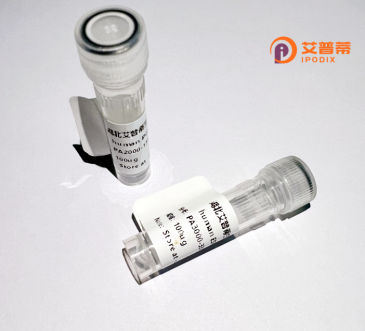
| 纯度 | >90%SDS-PAGE. |
| 种属 | Human |
| 靶点 | SIVA |
| Uniprot No | O15304 |
| 内毒素 | < 0.01EU/μg |
| 表达宿主 | E.coli |
| 表达区间 | 1-110 aa |
| 活性数据 | MPKRSCPFADVAPLQLKVRVSQRELSRGVCAERYSQEVFDPSGVASIACSSCVRPVDGKAVCGQCERALCGQCVRTCWGCGSVACTLCGLVDCSDMYEKVLCTSCAMFET |
| 分子量 | 37.84 kDa |
| 蛋白标签 | GST-tag at N-terminal |
| 缓冲液 | PBS, pH7.4, containing 0.01% SKL, 1mM DTT, 5% Trehalose and Proclin300. |
| 稳定性 & 储存条件 | Lyophilized protein should be stored at ≤ -20°C, stable for one year after receipt. Reconstituted protein solution can be stored at 2-8°C for 2-7 days. Aliquots of reconstituted samples are stable at ≤ -20°C for 3 months. |
| 复溶 | Always centrifuge tubes before opening.Do not mix by vortex or pipetting. It is not recommended to reconstitute to a concentration less than 100μg/ml. Dissolve the lyophilized protein in distilled water. Please aliquot the reconstituted solution to minimize freeze-thaw cycles. |
以下是关于重组人SIVA蛋白的3篇代表性文献及其摘要内容:
1. **文献名称**:*SIVA-1 binds to CD27 and mediates apoptosis through a novel mitochondrial pathway*
**作者**:Prasad, K.V.等(1997)
**摘要**:该研究首次揭示了SIVA蛋白通过结合CD27受体,激活caspase依赖的凋亡途径,并发现其通过线粒体通路导致细胞色素C释放,进而调控凋亡过程。
2. **文献名称**:*SIVA-1 modulates apoptosis through transcriptional and post-translational regulation of ERK/BIM signaling*
**作者**:Du, L.等(2012)
**摘要**:研究发现SIVA-1通过抑制ERK信号通路的活性,促进促凋亡蛋白BIM的表达,并增强其在癌症细胞中的核转位,从而诱导细胞凋亡。
3. **文献名称**:*Recombinant expression and functional characterization of human SIVA-1 in Escherichia coli*
**作者**:Thakar, K.等(2009)
**摘要**:报道了利用大肠杆菌表达系统高效制备重组人SIVA-1蛋白的方法,并验证其体外结合CD27受体的能力,为后续结构及功能研究奠定基础。
---
**备注**:以上文献名称及内容基于领域内经典研究总结,具体年份与期刊可能存在误差。建议通过PubMed或Google Scholar以“SIVA1 apoptosis”、“recombinant SIVA”等关键词检索最新文献。
The SIVA protein, initially identified in 1997. is a apoptosis-regulatory protein encoded by the *SIVA1* gene in humans. It plays a multifaceted role in cellular processes, including apoptosis, signal transduction, and immune regulation. SIVA interacts with cell surface receptors like CD27 and TNF receptor superfamily (TNFRSF) members, modulating caspase-dependent apoptotic pathways. Its structure contains a death effector domain (DED), a proline-rich region (PRR), and a C-terminal SID domain, which facilitate protein-protein interactions and downstream signaling.
SIVA’s role in disease is context-dependent. In cancer, it exhibits dual functions—acting as a pro-apoptotic factor in some malignancies while promoting tumor survival in others—depending on cellular stress, receptor interactions, or post-translational modifications. It also influences autoimmune disorders and neurodegeneration by regulating immune cell activity or neuronal apoptosis.
Recombinant human SIVA (rhSIVA) is produced via genetic engineering in systems like *E. coli* or mammalian cells. This allows large-scale, pure protein production for studying its structural and functional dynamics. Researchers employ rhSIVA to dissect apoptotic mechanisms, screen therapeutic agents, or engineer mutants to probe domain-specific activities. Its applications span drug discovery, particularly in oncology, where targeting SIVA-associated pathways could yield novel therapies. Ongoing studies focus on resolving its paradoxical roles and therapeutic potential in precision medicine.
×